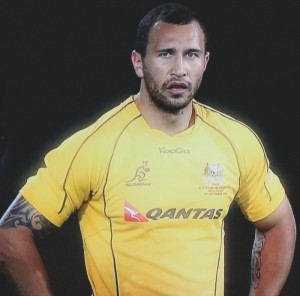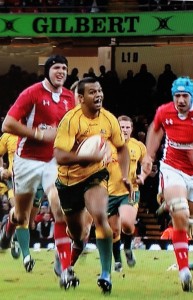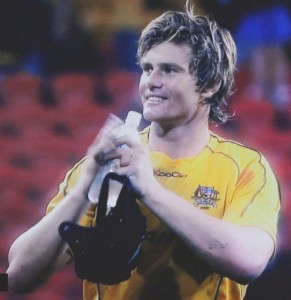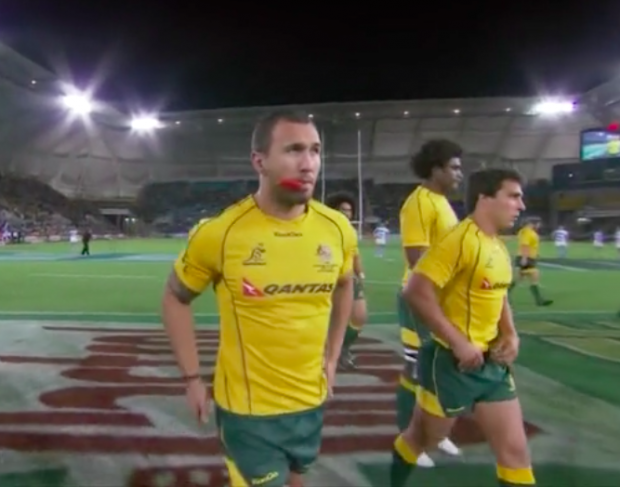Queensland Reds fans breathed a sigh of relief as Quade Cooper agreed to the terms of a two-year deal with the ARU last Friday.
The hoo-ha around these negotiations is well known. But what of the fundamental question behind them: is Quade as a player worth the dough?

Quade Cooper is a wonderful player when he is on his game and now that he has been through the wringer perhaps he will be a happier camper and be contrite.
If he can shift up a gear in big Test matches — e.g. against the All Blacks — we will soon forget his goose behaviour. He is a unique player in Oz rugby. He has the long flat passes on the money both ways as Steve Larkham had, but his abillity to pass chest-on, and thereby add to the threat of players inside or outside, is even better than that of the great Bernie.
If he hasn’t shown his best in big matches so far, the other Oz fly-halves also all have shortcomings.

Kurtley Beale, as Matt Giteau was before him, is like a centre or back three player: wanting to do well for his teammates outside him, of course, but by nature a seeker of the outside break. Like Giteau did, KB robs his outside runners of the space they need, though at least he recognises such an error earlier than Gits did, and passes the ball sooner. But those extra steps can be enough to compromise a backline move; it’s the Einstein space-time thing (see photo below).
James O’Connor runs square-on to traffic; not to add value to his outside or inside men, but to be in a position to step either way. It should be his secondary role: to get defenders fixed so they don’t drift onto the paths of support runners. But too often it is the step and not the pass that is his main interest. Not a bad trait at 12, but limiting at 10.
Berrick Barnes is an all-rounder but stands too deep to be a good facilitator of others, which means that the guys he passes to have too much to do before they get to the gain line. Most often they have to breach the tackle line to get there, so Barnes tends to kick a lot.

Michael Lynagh stood deep and old Naas Botha did too — but they knew how to kick and therefore were effective. Barnes has to play closer to the bulls and if he does he won’t kick as much; won’t be able to, and won’t have to.
Christian Leali’ifano should be added to this list. His shortcoming was not being the game changer his Brumbies coaches were looking for over the years. Season-ending injuries and the presence of Giteau (in two stints) didn’t help his progress, but 2012 was going to be different.
He was the form Aussie Super player this year and would have figured in selection for the Wallabies, but he suffered yet another serious injury. It was a pity because he has it all, or at least, chunks of all the bits of it all.
Where are Aussie fly-halves at? What do these fellows have to do better?
They have to kick less and even if they don’t, they have to kick better. They have to be facilitators and add value to the players around them better. They, or other first receivers from the ruck, have to take advantage of turnover ball at which time opponents are not configured for defence. The Wallabies were better at transition play in the 1980s than they are now, 30 years later.

Nor should they be reluctant to attack from deep every now and then. Other teams do this: the All Blacks, of course, but did we not see Wales attack brilliantly from deep after a set piece move against the Wallabies? They did, because they remembered that the defending fullback would most often be expecting the kick from runners still in their own 22. They would be back, waiting for it, and not in the tackle line. In the same situation the Wallabies might have seen the fullback back there and kicked to him, more or less as a courtesy.
As for their tactical kicking generally: at least it is good to see a left-foot kicker, Ben Tapuai, close to the action, and another, Drew Mitchell, helping with clearing kicks, but generally Aussie kicking, even when appropriate, is of poor quality. They were fortunate not to get any crap weather conditions on tour and have to kick their way around the park.
But I digress.
Is Quade Cooper worth the money?
If he can lift his game so that he can play his Super Rugby style in big Test matches with teammates not used to him day-in day-out, he will make a big difference to the Wallabies. It’s a big ‘if’ and one that is maybe too early to ponder in respect of the Lions tour, but you never know. If Tapuai can play at 12 next to him in every game for the Reds in Super Rugby, Robbie Deans — not a vindictive man if I read him right — may think that combo is a goer.
Quade could be worth it; every dollar.

